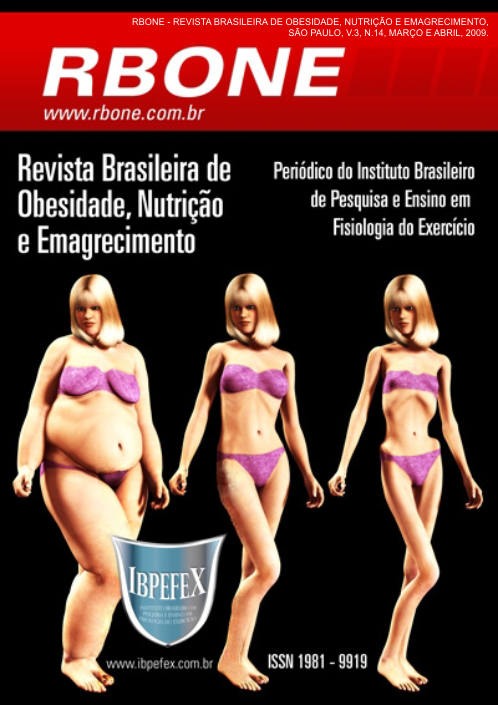Measuring symptoms of eating disorder in adolescents with age between 15 and 19 years old from state and private schools from the city of Santa Cruz do Capibaribe - PE
Abstract
Nowadays eating disorders are an important health problem, because of the number of factors which influence its appearance, in general, the victims are females teenagers and young adults. Objective: to qualify the prevalence of eating disorders in teenagers students in Santa Cruz do Capibaribe – Pe, and to evidence if there are differences between male and female and also in social economic level. Materials and Methodology: It was interviewed 491 students from both sex with ages between 15 and 19 years old, enrolled in private and state schools. It was used self-answered questionnaires EAT - 26 and BITE. Results: It was identified a bigger number of probable students with eating disorders in private schools (27.16%) most of them in females (59.51%). The occurrence of possible cases of Anorexia Nervosa (24.59%) was a little bigger than Bulimia Nervosa (24.12%). Discussion: The high prevalence of disorders found in this study show a strong influence of the globalization process in the diffusion of these disorders, and the fact of belonging to some social class, is not the main point to the appearing of eating disorders. Conclusion: The results found in this work are relevant to several health professionals, hoping that, in future researches, they can clarify in a better way the possible risks factors of these eating disorders.
References
- Alvarenga, M.; Larino, M.A. Terapia Nutricional na Anorexia e Bulimia Nervosas. Revista Brasileira de Psiquiatria. São Paulo. Vol. 24. Suppl. 3. 2002. p. 39-43.
- Assumpção, C.L.; Cabral, M.D. Complicações Clínicas da Anorexia e Bulimia Nervosa. Revista Brasileira de Psiquiatria. Rio de Janeiro. Vol. 24. Suppl. 3. 2002. p. 29-33.
- Chemin, C.; Milito, F. Transtornos Alimentares em Adolescentes. Revista Brasileira de Obesidade, Nutrição e Emagrecimento. São Paulo. Vol. 1. Num. 2. mar/abr. 2005. p. 84-88.
- Chiodini, J.S.; Oliveira M.R.M. Comportamento Alimentar de Adolescentes: Aplicação do EAT-26 em uma Escola Pública. Saúde em Revista. Piracicaba. Vol. 5. Num. 9. 2003. p, 53-58.
- Cordás, T.A. Transtornos Alimentares: Classificação e Diagnóstico. Revista de Psiquiatria Clínica. São Paulo. Vol. 31. Num. 4. 2004. p. 154-157.
- Cordás, T.A.; Claudino, A.M. Transtornos Alimentares: Fundamentos Históricos. Revista Brasileira de Psiquiatria. São Paulo. Vol. 24. Suppl. 3. dez. 2002. p. 03-06.
- Correa V.M.L.; Zubarew G.T.; Silva M.P.; Romero S.M.I. Prevalencia de Riesgo de Trastornos Alimentarios en Adolescentes Mujeres Escolares de la Región Metropolitana. Revista Chilena de Pedriatia. Santiago. Vol. 77. Num. 2. abr. 2006. p. 153-160.
- Freitas, S.; Gorenstein, C.; Appolinario, J.C. Instrumentos para a Avaliação dos Transtornos Alimentares. Revista Brasileira de Psiquiatria. Alvarenga. Vol. 24. Suppl. 3. dez. 2002. p. 34-38.
- Ida, S.W.; Silva, R.N. Transtornos Alimentares: uma Perspectiva Social. Revista Mal-estar e Subjetividade. Fortaleza. Vol. 7. Num. 2. set. 2007. p. 417-432.
- Instituto Brasileiro de Geografia e Estatística. Contagem da População: Brasil 2007. Disponível em: <http://www.ibge.gov.br/ home/estatistica/populacao/contagem2007/PE.pdf>. Acesso em: 02 dez. 2008.
- Latterza, A.R.; Dunker, K.L.; Scagliusi, F.B.; Kemen, E. Tratamento Nutricional dos Transtornos Alimentares. Revista de Psiquiatria Clínica. São Paulo. Vol. 31. Num. 4. 2004. p. 173-176.
- Magalhães, V.C.; Azevedo, G.; Mendonça, S. Transtornos Alimentares em Universitárias: Estudo de Confiabilidade da Versão Brasileira de Questionários Autopreenchíveis. Revista Brasileira de Epidemiologia. São Paulo. Vol. 8. Num. 3. set. 2005. p. 236-245.
- Melin, P.; Araújo, A.M. Transtornos Alimentares em Homens: um Desafio Diagnóstico. Revista Brasileira de Psiquiatria. São Paulo. Vol. 24. Suppl. 3. 2002. p. 73-76.
- Morgan, C.M.; Vecchiatti, I.R.; Negrão, A.B. Etiologia dos Transtornos Alimentares: Aspectos Biológicos, Psicológicos e Sócio-culturais. Revista Brasileira de Psiquiatria. São Paulo. Vol. 24. Suppl. 3. 2002. p. 18-23.
- Murphy, T.; Treasure, J. Transtornos Alimentares. In: Teixeira, F.N. Nutrição Clínica. 1. ed. Rio de Janeiro: Guanabara. 2003. p. 78-90.
- Penz, L.R.; Bosco, S.M.D.; Vieira, J.M. Risco para Desenvolvimento de Transtornos Alimentares em Estudantes de Nutrição. Scientia Medica. Porto Alegre. Vol. 18. Num. 3. jul./set. 2008. p. 124-128.
- Serra, G.M.A.; Santos, E.M. Saúde e Mídia na Construção da Obesidade e do Corpo Perfeito. Ciência & Saúde Coletiva. Rio de Janeiro. Vol. 8. Num. 3. 2003. p. 691-701.
- Vilela, J.E.M.; Lamounier, J.A.; Dellaretti Filho, M.A.; Barros Neto, J.R.; Horta, G.M. Transtornos Alimentares em Escolares. Jornal de Pediatria. Rio de Janeiro. Vol. 80. Num. 1. fev. 2004. p. 49-54.
Authors who publish in this journal agree to the following terms:
- Authors retain the copyright and grant the journal the right of first publication, with work simultaneously licensed under the Creative Commons Attribution License BY-NC which allows the sharing of the work with acknowledgment of the authorship of the work and initial publication in this journal.
- Authors are authorized to enter into additional contracts separately for non-exclusive distribution of the version of the work published in this journal (eg, publishing in institutional repository or book chapter), with acknowledgment of authorship and initial publication in this journal.
- Authors are allowed and encouraged to post and distribute their work online (eg, in institutional repositories or on their personal page) at any point before or during the editorial process, as this can bring about productive change as well as increase impact and impact. citation of published work (See The Effect of Free Access).






